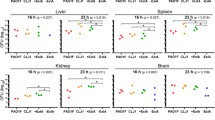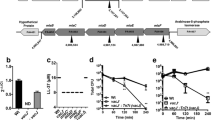Abstract
Many bacterial pathogens have evolved ingenious ways to escape from the lung during pneumonia to cause bacteremia. Unfortunately, the clinical consequences of this spread to the bloodstream are frequently dire. It is therefore important to understand the molecular mechanisms used by pathogens to breach the lung barrier. We have recently shown that Pseudomonas aeruginosa, one of the leading causes of hospital-acquired pneumonia, utilizes the type III secretion system effector ExoS to intoxicate pulmonary epithelial cells. Injection of these cells leads to localized disruption of the pulmonary-vascular barrier and dissemination of P. aeruginosa to the bloodstream. We put these data in the context of previous studies to provide a holistic model of P. aeruginosa dissemination from the lung. Finally, we compare P. aeruginosa dissemination to that of other bacteria to highlight the complexity of bacterial pneumonia. Although respiratory pathogens use distinct and intricate strategies to escape from the lungs, a thorough understanding of these processes can lay the foundation for new therapeutic approaches for bacterial pneumonia.

Similar content being viewed by others
References
Achouiti A et al (2012) Myeloid-related protein-14 contributes to protective immunity in gram-negative pneumonia derived sepsis. PLoS Pathog 8:e1002987. doi:10.1371/journal.ppat.1002987
Balamayooran G, Batra S, Theivanthiran B, Cai S, Pacher P, Jeyaseelan S (2012) Intrapulmonary G-CSF rescues neutrophil recruitment to the lung and neutrophil release to blood in Gram-negative bacterial infection in MCP-1-/- mice. J Immunol 189:5849–5859. doi:10.4049/jimmunol.1200585
Barbieri AM, Sha Q, Bette-Bobillo P, Stahl PD, Vidal M (2001) ADP-ribosylation of Rab5 by ExoS of Pseudomonas aeruginosa affects endocytosis. Infect Immun 69:5329–5334
Berube BJ, Bubeck Wardenburg J (2013) Staphylococcus aureus alpha-toxin: nearly a century of intrigue. Toxins (Basel) 5:1140–1166
Bhowmick R, Tin Maung NH, Hurley BP, Ghanem EB, Gronert K, McCormick BA, Leong JM (2013) Systemic disease during Streptococcus pneumoniae acute lung infection requires 12-lipoxygenase-dependent inflammation. J Immunol 191:5115–5123. doi:10.4049/jimmunol.1300522
Bubeck Wardenburg J, Schneewind O (2008) Vaccine protection against Staphylococcus aureus pneumonia. J Exp Med 205:287–294. doi:10.1084/jem.20072208
Bubeck Wardenburg J, Bae T, Otto M, Deleo FR, Schneewind O (2007) Poring over pores: alpha-hemolysin and Panton-Valentine leukocidin in Staphylococcus aureus pneumonia. Nat Med 13:1405–1406. doi:10.1038/nm1207-1405
de Boer JD et al (2014) Overexpression of activated protein C hampers bacterial dissemination during pneumococcal pneumonia. BMC Infect Dis 14:559. doi:10.1186/s12879-014-0559-3
Duitman J, Hoogendijk AJ, Groot AP, Ruela de Sousa RR, van der Poll T, Florquin S, Spek CA (2012a) CCAAT-enhancer binding protein delta (C/EBPdelta) protects against Klebsiella pneumoniae-induced pulmonary infection: potential role for macrophage migration. J Infect Dis 206:1826–1835. doi:10.1093/infdis/jis615
Duitman J et al (2012b) CCAAT/enhancer-binding protein delta facilitates bacterial dissemination during pneumococcal pneumonia in a platelet-activating factor receptor-dependent manner. Proc Natl Acad Sci USA 109:9113–9118. doi:10.1073/pnas.1202641109
El-Solh AA, Hattemer A, Hauser AR, Alhajhusain A, Vora H (2012) Clinical outcomes of type III Pseudomonas aeruginosa bacteremia. Crit Care Med 40:1157–1163. doi:10.1097/CCM.0b013e3182377906
Fagon JY, Chastre J, Domart Y, Trouillet JL, Pierre J, Darne C, Gibert C (1989) Nosocomial pneumonia in patients receiving continuous mechanical ventilation. Prospective analysis of 52 episodes with use of a protected specimen brush and quantitative culture techniques. Am Rev Respir Dis 139:877–884. doi:10.1164/ajrccm/139.4.877
Feltman H, Schulert G, Khan S, Jain M, Peterson L, Hauser AR (2001) Prevalence of type III secretion genes in clinical and environmental isolates of Pseudomonas aeruginosa. Microbiology 147:2659–2669
Fraylick JE, La Rocque JR, Vincent TS, Olson JC (2001) Independent and coordinate effects of ADP-ribosyltransferase and GTPase-activating activities of exoenzyme S on HT-29 epithelial cell function. Infect Immun 69:5318–5328
George DL et al (1998) Epidemiology of ventilator-acquired pneumonia based on protected bronchoscopic sampling. Am J Respir Crit Care Med 158:1839–1847. doi:10.1164/ajrccm.158.6.9610069
Goehring UM, Schmidt G, Pederson KJ, Aktories K, Barbieri JT (1999) The N-terminal domain of Pseudomonas aeruginosa exoenzyme S is a GTPase-activating protein for Rho GTPases. J Biol Chem 274:36369–36372
Golovkine G, Faudry E, Bouillot S, Voulhoux R, Attree I, Huber P (2014) VE-cadherin cleavage by LasB protease from Pseudomonas aeruginosa facilitates type III secretion system toxicity in endothelial cells. PLoS Pathog 10:e1003939. doi:10.1371/journal.ppat.1003939
Gouaux E (1998) alpha-Hemolysin from Staphylococcus aureus: an archetype of beta-barrel, channel-forming toxins. J Struct Biol 121:110–122. doi:10.1006/jsbi.1998.3959
Hauser AR (2009) The type III secretion system of Pseudomonas aeruginosa: infection by injection. Nat Rev Microbiol 7:654–665. doi:10.1038/nrmicro2199
Heiniger RW, Winther-Larsen HC, Pickles RJ, Koomey M, Wolfgang MC (2010) Infection of human mucosal tissue by Pseudomonas aeruginosa requires sequential and mutually dependent virulence factors and a novel pilus-associated adhesin. Cell Microbiol 12:1158–1173. doi:10.1111/j.1462-5822.2010.01461.x
Heyland DK, Cook DJ, Griffith L, Keenan SP, Brun-Buisson C (1999) The attributable morbidity and mortality of ventilator-associated pneumonia in the critically ill patient. The Canadian Critical Trials Group. Am J Respir Crit Care Med 159:1249–1256. doi:10.1164/ajrccm.159.4.9807050
Hoogerwerf JJ et al (2012) Interleukin-1 receptor-associated kinase M-deficient mice demonstrate an improved host defense during Gram-negative pneumonia. Mol Med 18:1067–1075. doi:10.2119/molmed.2011.00450
Huber P, Bouillot S, Elsen S, Attree I (2014) Sequential inactivation of Rho GTPases and Lim kinase by Pseudomonas aeruginosa toxins ExoS and ExoT leads to endothelial monolayer breakdown. Cell Mol Life Sci CMLS 71:1927–1941. doi:10.1007/s00018-013-1451-9
Inoshima I, Inoshima N, Wilke GA, Powers ME, Frank KM, Wang Y, Bubeck Wardenburg J (2011) A Staphylococcus aureus pore-forming toxin subverts the activity of ADAM10 to cause lethal infection in mice. Nat Med 17:1310–1314. doi:10.1038/nm.2451
Inoshima N, Wang Y, Wardenburg JB (2012) Genetic requirement for ADAM10 in severe Staphylococcus aureus skin infection. J Invest Dermatol 132:1513–1516. doi:10.1038/jid.2011.462
Kalin M et al (2000) Prospective study of prognostic factors in community-acquired bacteremic pneumococcal disease in 5 countries. J Infect Dis 182:840–847. doi:10.1086/315760
Klevens RM et al (2007) Invasive methicillin-resistant Staphylococcus aureus infections in the United States. JAMA J Am Med Assoc 298:1763–1771. doi:10.1001/jama.298.15.1763
Laichalk LL, Kunkel SL, Strieter RM, Danforth JM, Bailie MB, Standiford TJ (1996) Tumor necrosis factor mediates lung antibacterial host defense in murine Klebsiella pneumonia. Infect Immun 64:5211–5218
Lowy FD (1998) Staphylococcus aureus infections. N Engl J Med 339:520–532. doi:10.1056/NEJM199808203390806
Luttge M et al (2012) Streptococcus pneumoniae induces exocytosis of Weibel-Palade bodies in pulmonary endothelial cells. Cell Microbiol 14:210–225. doi:10.1111/j.1462-5822.2011.01712.x
Magret M et al (2011) Bacteremia is an independent risk factor for mortality in nosocomial pneumonia: a prospective and observational multicenter study. Crit Care 15:R62. doi:10.1186/cc10036
Marfin AA, Sporrer J, Moore PS, Siefkin AD (1995) Risk factors for adverse outcome in persons with pneumococcal pneumonia. Chest 107:457–462
Moore TA, Perry ML, Getsoian AG, Newstead MW, Standiford TJ (2002) Divergent role of gamma interferon in a murine model of pulmonary versus systemic Klebsiella pneumoniae infection. Infect Immun 70:6310–6318
Mufson MA (1981) Pneumococcal infections. JAMA J Am Med Assoc 246:1942–1948
Pederson KJ, Barbieri JT (1998) Intracellular expression of the ADP-ribosyltransferase domain of Pseudomonas exoenzyme S is cytotoxic to eukaryotic cells. Mol Microbiol 30:751–759
Pederson KJ, Vallis AJ, Aktories K, Frank DW, Barbieri JT (1999) The amino-terminal domain of Pseudomonas aeruginosa ExoS disrupts actin filaments via small-molecular-weight GTP-binding proteins. Mol Microbiol 32:393–401
Pena C et al (2013) Effect of adequate single-drug vs combination antimicrobial therapy on mortality in Pseudomonas aeruginosa bloodstream infections: a post Hoc analysis of a prospective cohort. Clin Infect Dis 57:208–216. doi:10.1093/cid/cit223
Penaloza HF et al (2015) Interleukin-10 plays a key role in the modulation of neutrophils recruitment and lung inflammation during infection by Streptococcus pneumoniae. Immunology 146:100–112. doi:10.1111/imm.12486
Podschun R, Ullmann U (1998) Klebsiella spp. as nosocomial pathogens: epidemiology, taxonomy, typing methods, and pathogenicity factors. Clin Microbiol Rev 11:589–603
Rangel SM, Logan LK, Hauser AR (2014) The ADP-ribosyltransferase domain of the effector protein ExoS inhibits phagocytosis of Pseudomonas aeruginosa during pneumonia. MBio 5:e01014–e01080. doi:10.1128/mBio.01080-14
Rangel SM, Diaz MH, Knoten CA, Zhang A, Hauser AR (2015) The role of ExoS in dissemination of Pseudomonas aeruginosa during pneumonia. PLoS Pathog 11:e1004945. doi:10.1371/journal.ppat.1004945
Rello J, Gallego M, Mariscal D, Sonora R, Valles J (1997) The value of routine microbial investigation in ventilator-associated pneumonia. Am J Respir Crit Care Med 156:196–200. doi:10.1164/ajrccm.156.1.9607030
Rocha CL, Coburn J, Rucks EA, Olson JC (2003) Characterization of Pseudomonas aeruginosa exoenzyme S as a bifunctional enzyme in J774A.1 macrophages. Infect Immun 71:5296–5305
Rosendahl A, Bergmann S, Hammerschmidt S, Goldmann O, Medina E (2013) Lung dendritic cells facilitate extrapulmonary bacterial dissemination during pneumococcal pneumonia. Front Cell Infect Microbiol 3:21. doi:10.3389/fcimb.2013.00021
Saftig P, Hartmann D (2005) ADAM10 The ADAM family of proteases. In: Hooper NM, Lendeckel U (eds) Proteases in biology and disease, vol 4. Springer, USA, pp 85–121. doi:10.1007/0-387-25151-0_5
Shaver CM, Hauser AR (2004) Relative contributions of Pseudomonas aeruginosa ExoU, ExoS, and ExoT to virulence in the lung. Infect Immun 72:6969–6977. doi:10.1128/IAI.72.12.6969-6977.2004
Song L, Hobaugh MR, Shustak C, Cheley S, Bayley H, Gouaux JE (1996) Structure of staphylococcal alpha-hemolysin, a heptameric transmembrane pore. Science 274:1859–1866
Soong G, Parker D, Magargee M, Prince AS (2008) The type III toxins of Pseudomonas aeruginosa disrupt epithelial barrier function. J Bacteriol 190:2814–2821. doi:10.1128/JB.01567-07
Stryjewski M, Sexton DJ (2003) Pseudomonas aeruginosa infections in specific types of patients and clinical settings. In: Hauser A, Rello, J (eds) Severe infections caused by Pseudomonas aeruginosa. Kluwer Academic Publishers, Boston, pp 1–15. doi:10.1007/978-1-4613-0433-7
Sullivan AB, Tam KP, Metruccio MM, Evans DJ, Fleiszig SM (2015) The importance of the Pseudomonas aeruginosa type III secretion system in epithelium traversal depends upon conditions of host susceptibility. Infect Immun 83:1629–1640. doi:10.1128/IAI.02329-14
Torres JM, Cardenas O, Vasquez A, Schlossberg D (1998) Streptococcus pneumoniae bacteremia in a community hospital. Chest 113:387–390
van den Boogaard FE, Brands X, Roelofs JJ, de Beer R, de Boer OJ, van ‘t Veer C, van der Poll T (2014) Mast cells impair host defense during murine Streptococcus pneumoniae pneumonia. J Infect Dis 210:1376–1384 doi:10.1093/infdis/jiu285
Wilke GA, Bubeck Wardenburg J (2010) Role of a disintegrin and metalloprotease 10 in Staphylococcus aureus alpha-hemolysin-mediated cellular injury. Proc Natl Acad Sci USA 107:13473–13478. doi:10.1073/pnas.1001815107
Xu X, Weiss ID, Zhang HH, Singh SP, Wynn TA, Wilson MS, Farber JM (2014) Conventional NK cells can produce IL-22 and promote host defense in Klebsiella pneumoniae pneumonia. J Immunol 192:1778–1786. doi:10.4049/jimmunol.1300039
Zhao Y et al (2015) Thrombospondin-1 restrains neutrophil granule serine protease function and regulates the innate immune response during Klebsiella pneumoniae infection. Mucosal Immunol 8:896–905. doi:10.1038/mi.2014.120
Author information
Authors and Affiliations
Corresponding author
Additional information
Communicated by M. Kupiec.
Rights and permissions
About this article
Cite this article
Berube, B.J., Rangel, S.M. & Hauser, A.R. Pseudomonas aeruginosa: breaking down barriers. Curr Genet 62, 109–113 (2016). https://doi.org/10.1007/s00294-015-0522-x
Received:
Revised:
Accepted:
Published:
Issue Date:
DOI: https://doi.org/10.1007/s00294-015-0522-x




